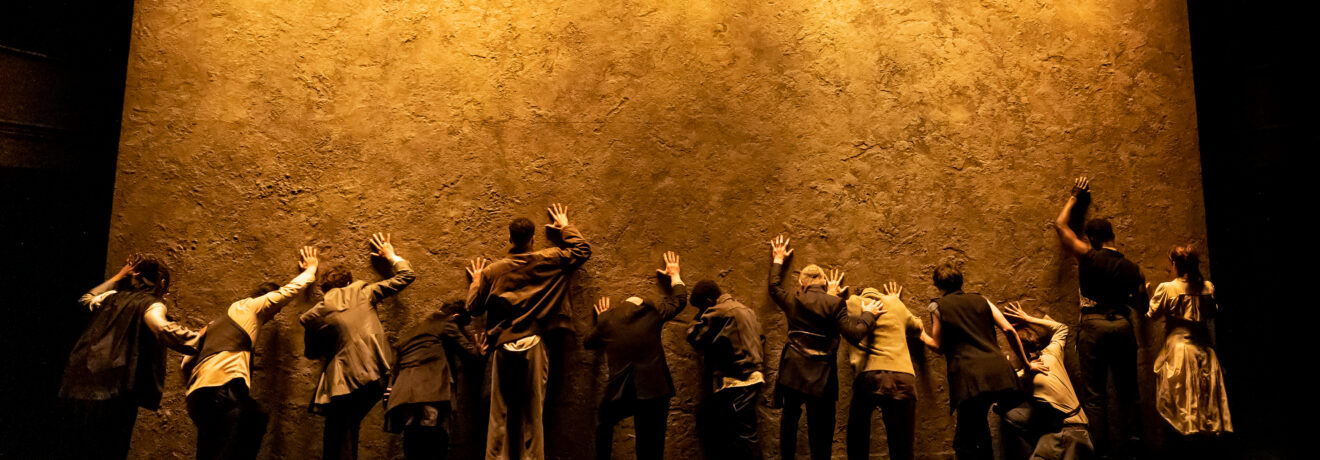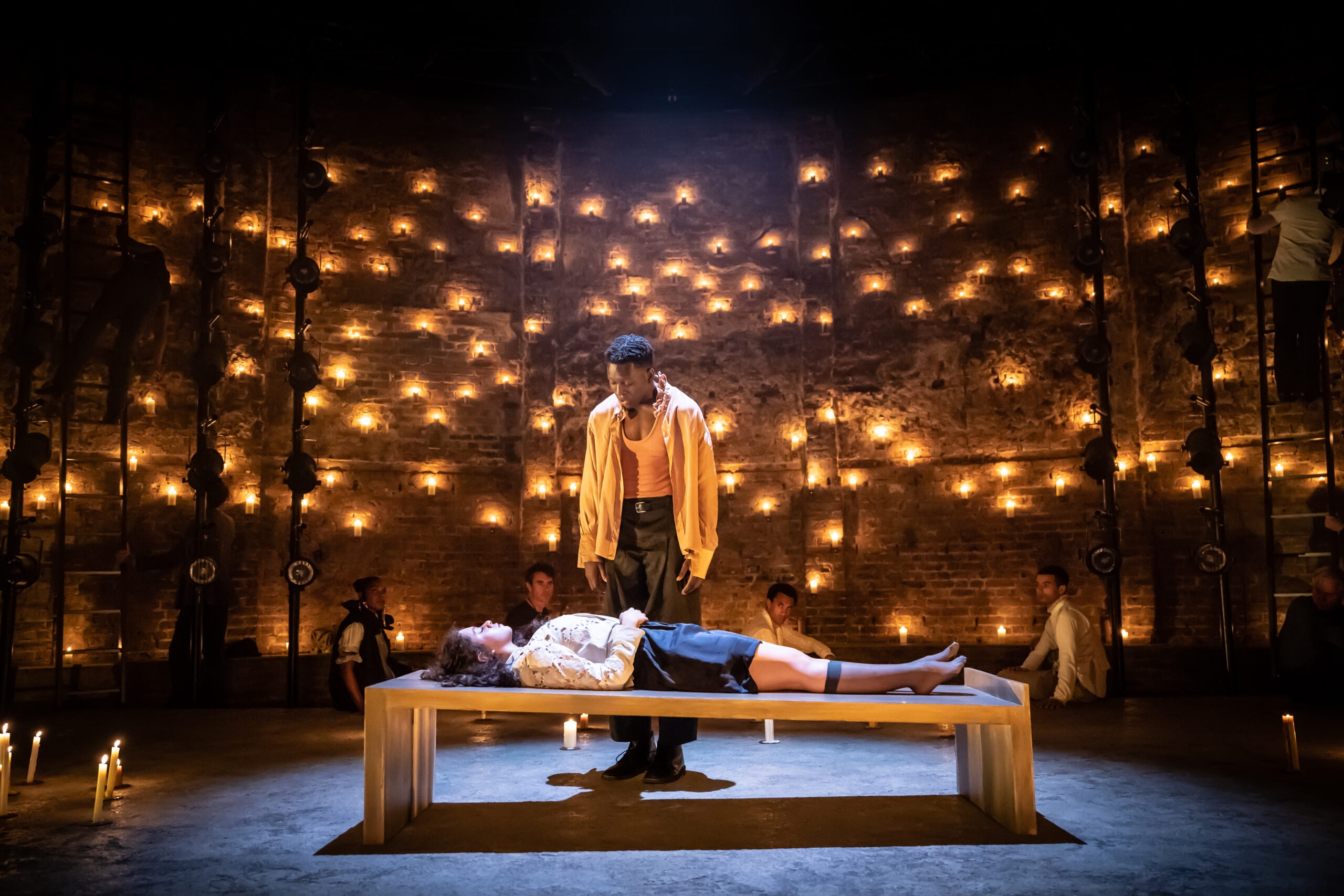Theater Reviews
The Almeida’s Romeo and Juliet: A Review

Entering the Almeida theatre in June, I was surprised not to see the signature exposed brick back wall. Instead, what looked like a screen painted with sand covered the entire front of the stage. When the house lights went down, actors entered and took up poses appearing to press against the screen as the prologue was projected onto it line by line. At its conclusion, the screen fell back, becoming a raised platform on which much of the play’s action unfolded. This opening sequence characterized one of the three main strengths of the performance: its visual power. The image of a mass of bodies straining against the story they were about to tell, embodied as an obstacle in their way, powerfully communicated the extent to which this production would foreground a feeling of tense constriction.
Directed by Rebecca Frecknall, the Almeida’s Romeo and Juliet was cut to a relatively brisk two hours and played without intermission, a choice that further fostered that feeling of tension and constriction. Toheeb Jimoh (Romeo) and Isis Hainsworth (Juliet) played the lovers as young and eager, often stirring the audience to laughter along with them as the characters’ joy spilled over. Both handled the text beautifully, and Hainsworth exuded the energy of an impetuous, impassioned teen with wide-eyed eagerness and excitement. The set design was minimal, the costuming contemporary. For much of the play, most of the cast remained onstage, either seated on a bench against the back wall or sitting on the stage, leaning against the platform. Sometimes the actors around the perimeter appeared to be watching the action unfold. At other times they did not. Their ongoing presence, despite the extremely bare stage, created a sense of enclosure and entrapment, as if Romeo and Juliet were always observed, always under the watchful eye and potential control of those around them. The presence of an onstage audience, of course, also heightened theatregoers’ awareness of their own voyeurism, contributing to the overall tension of the production.
A second major strength of the production was its choreography. Frecknall has a background in movement and presumably, along with fight director Jonathan Holby, was responsible for the choreography. The movement merged the contemporary design with choices reminiscent of classical ballet. The impression was reinforced by the use of Prokofiev’s Romeo and Juliet ballet score repeatedly. In particular, the familiar theme from “Dance of the Knights,” underscoring the Montagues’ and Capulets’ violent disputes, returned at several points in the production. Large groups of members of the company danced in tight phalanxes to the percussive, threatening score. The ballet often morphed into (and out of) fight sequences. Even those scenes without fights, such as the Capulet ball, felt on the edge of violence with this choreography. The men, including Benvolio, Mercutio, and Tybalt, menacingly danced around Juliet, hemming her in as she first danced with Paris and then, Romeo, at which point they began to recede. The production didn’t include any cross-gender casting, and it also cut Lady Montague. Thus, there were only three women in the play: the Nurse, Lady Capulet, and Juliet. The physical menace of the male dancers underscored that gender imbalance and provided threatening visual reminders of the extent to which Juliet was contained. It could be easy to forget the gender politics of the play when costumed in contemporary dress. But the dancing insisted upon our recalling Juliet’s isolation and restriction. This focus was particularly evident in 4.3, when Juliet’s anxiety about taking the drug Friar Lawrence (Paul Higgins) gave her played out via an intense dance sequence. It began with a recreation of Tybalt’s death, making more space in this production for Juliet’s grief over her cousin than I’ve seen in many other versions. Juliet then breaks into a full dance as she is pursued variously by Capulet, Lady Capulet, Paris, Romeo, and others. The resulting visual powerfully conveyed that this Juliet was a young girl trapped between opposing forces and struggling to make any good choices. As the sequence closed, she was hemmed in by her parents and the Nurse, and she collapsed, the production then cutting directly to their discovery of her “dead” body.
The production made several interesting choices in terms of its treatment of gender and race. First, in choosing not to use cross-gender casting, it highlighted the limited power and roles of women. Second, most of the cast were actors of color, and while the production didn’t directly address this, it led to several resonant moments in performance. I’ll highlight two: Tybalt’s taunting of Romeo, and Capulet’s fury with a disobedient Juliet. In the first example, Tybalt (Jyuddah Jaymes) hurling insults at Romeo hit differently as both men were Black. Tybalt’s spit exclamation, “Boy, this shall not excuse the injuries / That thou hast done me,” (3.1.65-66, emphasis mine) reverberated with the weight of years of racist insult. Secondly, Capulet (Jamie Ballard) showed truly distressing anger toward the production’s women in 3.5 when Juliet refused to marry Paris. Capulet had been so jolly throughout the production to that point, it was difficult to imagine he would turn violent, and in a physical sense, his violence was limited. At one point, he pulled the Nurse (Jo McInnes) bodily from Juliet and pushed her down; at another point, he slammed the stage next to Juliet, making her jump. That said, his anger was terrifying, especially in contrast with his previous mellow good humor. And, to see a white man loom over and threaten the production’s only three women, two of them not white, rendered the production’s intersecting politics of race and gender highly visible. Lady Capulet (Amanda Bright) was clearly shell-shocked by her husband’s shift to anger and menace. The startling visual of a Black wife enduring verbal abuse from a furious white husband was extremely resonant for a contemporary audience.
The production’s third major strength was its handling of Juliet’s death. As mentioned above, the production design in general was quite minimal—bare platform stage, limited props, and simple contemporary costume. By contrast, 5.3 was richly visual. As Juliet’s body was placed on a bench to represent her family’s tomb, actors scaled ladders along the brick wall at the back of the stage and began lighting candles set into the bricks. The process was slow and captivating. At the same time, actors entered from the wings and placed lit pillar candles in clusters on the platform near where Juliet lay. While some might have found it distracting, I perceived it as both magical and deeply realistic—the embodied, laborious activity of lighting so many candles; the surprise of seeing real open flame in a theatre setting; and the slowly transforming nature of the light onstage. As this slow shift in illumination unfolded, Romeo heard the news of Juliet’s death, purchased his poison, and arrived in the tomb. (The production cut Paris’s death, further focusing audience attention only on Romeo and Juliet in the closing sequence.) As the action advanced, audiences could recognize the creation of the visual made famous from the production’s marketing materials: an ethereal Romeo and Juliet, lying on the ground, surrounded by the soft glow of candles. (Perhaps provoking a question: why might a theatre choose to advertise the story of the lovers with the image of their death?) In addition to the atmospheric lighting, the slow accumulation of candles contributed to the sense of an onstage audience observing and preparing for the deaths of the lovers, both honoring them and reinforcing the inevitability of the show’s funereal conclusion. Once the candles had all been lit or placed, the actors took seats on the stage, leaning on the platform and watching the final moments of Romeo’s and Juliet’s lives unfold.

Following what is now common tradition, Juliet awoke before Romeo died and observed his dying breaths. In frenzied horror, Juliet never gave him his final, desired kiss, instead screaming, “No, no, no, no!!” as he gasped and faded. From this moment, the production did not let up on the terror and heartbreak. Juliet, first cradling Romeo’s body while crying out, then searching him for more poison, rose and began pacing the stage, increasingly frantic. She started screaming as the full weight of how few choices she had landed. Eventually, out of options, Juliet returned to Romeo’s body and took his knife to kill herself. However, this was not an easy solution: Hainsworth conveyed Juliet’s fear clearly. Holding the knife in front of her, Juliet struggled to work herself up to delivering the killing blow, screaming and grunting in terror and frustration. Ultimately, Juliet’s death was visceral and embodied in a way I haven’t seen done before. There was no sense that this suicide was an obvious or peaceful choice for her, and no feeling of relief once she fell.
The horror of the moment expanded as the onstage audience of other actors drew close to observe Juliet dying, eventually closing in to stand around the onstage platform, blocking our view as they faced the dead bodies and bowed their heads. Once again, we were made uncomfortably complicit in the act of voyeuristically watching Juliet’s horrific struggle as the onstage audience’s curious consumption of her pain implicitly reflected our own. The lights went down and left the stage glowing from hundreds of candles until, suddenly, the lights came up and the actors faced us to bow. This conclusion felt like a thunderclap—the audience hesitated to applaud with Juliet’s final, agonized scream still echoing in the air, our hearts in our throats. There was no “a glooming peace this morning with it brings” (5.3.305), no princely intervention, priestly revelation, or parental reconciliation. The production trapped us, like it had trapped Juliet, in a moment of restriction and horror, and left us there.
While the Almeida’s Romeo and Juliet was not without flaws, the overall impact of its visual power, unique use of choreography to craft tension, and powerfully startling take on the lovers’ deaths marked it as a production I won’t soon forget and one I’m incredibly glad to have seen.
